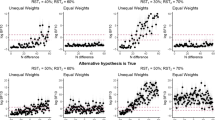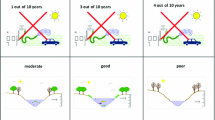Abstract
Choice Experiments present survey respondents with alternative options that are described by a number of attributes. Respondents are assumed to evaluate each option based on the levels of the attributes, which vary across alternatives and choice sets. The way in which attributes are described to respondents is likely to affect their choices. In this study, the impacts of two attribute level descriptions are assessed: describing non-market attributes as absolute levels or in relative terms; and using positive versus negative contextual descriptions of attribute levels. These tests were performed using data from a choice experiment on catchment management in Tasmania, Australia. Contrary to a priori expectations, including explicit information cues about relative attribute levels in the choice sets is not found to affect stated preferences. The data do reveal significant differences in value estimates when attribute levels are described as a ‘loss’, compared to a ‘presence’.
Similar content being viewed by others
References
ABS (2006) 2006 Census. Australian Bureau of Statistics, Canberra. Available via. http://www.abs.gov.au/websitedbs/D3310114.nsf/home/Census+data
ABS (2007) Statistics—Tasmania, 2007. Australian Bureau of Statistics, Canberra. Available via. http://www.abs.gov.au/AUSSTATS
Ajzen I, Brown TC, Rosenthal LH (1996) Information bias in contingent valuation: effects of personal relevance, quality of information, and motivational orientation. J Environ Econ Manag 30(1): 43–57
Alpízar F, Carlsson F, Martinsson P (2001) Using choice experiments for non-market valuation. Econ Issues 8(1): 83–110
Alvarez-Farizo B, Hanley N, Barberan R, Lazaro A (2007) Choice modeling at the “market stall”: individual versus collective interest in environmental valuation. Ecol Econ 60(4): 743–751
Bateman IJ, Brouwer R, Davies H, Day BH, Deflandre A, DiFalco S, Georgiou S, Hadley D, Hutchins M, Jones AP, Kay D, Leeks G, Lewis M, Lovett AA, Neal C, Posen P, Rigby D, Turner RK (2006) Analysing the agricultural costs and non-market benefits of implementing the water framework directive. J Agr Econ 57(2): 221–237
Bateman IJ, Day BH, Jones AP, Jude S (2009) Reducing gain-loss asymmetry: a virtual reality choice experiment valuing land use change. J Environ Econ Manag 58(1): 106–118
Bennett J, Adamowicz W (2001) Some fundamentals of environmental choice modelling. In: Bennett J, Blamey R (eds) The choice modelling approach to environmental valuation. Edward Elgar, Cheltenham
Bennett J, Dumsday R, Howell G, Lloyd C, Sturgess N, van Raalte L (2008) The economic value of improved environmental health in victorian rivers. Australas J Environ Manag 15(3): 138–148
Bergstrom JC, Stoll JC, Randall A (1990) The impact of information on environmental commodity valuation decisions. Am J Agr Econ 72(3): 614–621
Bosworth R, Ann Cameron T, DeShazo JR (2009) Demand for environmental policies to improve health: evaluating community-level policy scenarios. J Environ Econ Manag 57(3): 293–308
Braga J, Starmer C (2005) Preference anomalies, preference elicitation and the discovered preference hypothesis. Environ Resour Econ 32(1): 55–89
Break O’Day Council: (2007) Georges catchment and estuary project overview. Break O’Day Council, St Helens
Breffle WS, Rowe RD (2002) Comparing choice question formats for evaluating natural resource tradeoffs. Land Econ 78(2): 298–314
Campbell D, Hutchinson WG, Scarpa R (2008) Incorporating discontinuous preferences into the analysis of discrete choice experiments. Environ Resour Econ 41(3): 401–417
Carlsson F, Frykblom P, Liljenstolpe C (2003) Valuing wetland attributes: an application of choice experiments. Ecol Econ 47(1): 95–103
Caussade S, Ortuzar JD, Rizzi LI, Hensher DA (2005) Assessing the influence of design dimensions on stated choice experiment estimates. Transp Res Part B Methodol 39(7): 621–640
Davies PE, Long J, Brown M, Dunn H, Heffner D, Knight R (2005) The Tasmanian conservation of freshwater ecosystem values (CFEV) framework: developing a conservation and management system for rivers. Paper presented at the Freshwater Protected Areas Conference, Sydney, Australia, 27–28 Sept 2004
DeShazo JR, Fermo G (2002) Designing choice sets for stated preference methods: the effects of complexity on choice consistency. J Environ Econ Manag 44(1): 123–143
DPIW: (2005) Environmental management goals for Tasmanian surface waters. Dorset & Break O’Day municipal areas. Department of Primary Industries, Water and Environment, Hobart
DPIW: (2007) Annual waterways monitoring reports 2006: George catchment. Department of Primary Industries, Water and Environment, Hobart
Econometric Software: (2007) LIMDEP 9.0. Econometric Software Inc., Castle Hill
Entman RM (1993) Framing: towards a clarification of a fractured paradigm. J Commun 43(4): 51–58
Fischer GW, Damodaran N, Laskey KB, Lincoln D (1987) Preferences for proxy attributes. Manag Sci 33(2): 198–214
Ganzach Y, Karsahi N (1995) Message framing and buying behavior: a field experiment. J Bus Res 32(1): 11–17
Goffman E (1974) Frame analysis: an essay on the organization of experience. Harper & Row, New York
Greene WH, Hensher DA (2007) Heteroscedastic control for random coefficients and error components in mixed logit. Transp Res Part E Logist Transp Rev 43(5): 610–623
Greene WH, Hensher DA, Rose J (2006) Accounting for heterogeneity in the variance of unobserved effects in mixed logit models. Transp Res Part B Methodol 40(1): 75–92
Hallahan K (1999) Seven models of framing: implications for public relations. J Public Relat Res 11(3): 205–242
Hanley N, Colombo S, Tinch D, Black A, Aftab A (2006) Estimating the benefits of water quality improvements under the water framework directive: are benefits transferable. Eur Rev Agr Econ 33(3): 391–413
Hensher DA (2006) Revealing differences in willingness to pay due to the dimensionality of stated choice designs: an initial assessment. Environ Resour Econ 34(1): 7–44
Hensher DA (2006) How do respondents process stated choice experiments? Attribute consideration under varying information load. J Appl Econ 21(6): 861–878
Hensher DA, Greene WH (2003) The mixed logit model: the state of practice. Transportation 30: 133–176
Hensher DA, Rose JM, Black I (2008) Interactive agency choice in automobile purchase decisions: the role of negotiation in determining equilibrium choice outcomes. J Transp Econ Pol 42(2): 269–296
Hensher DA, Rose JM, Greene WH (2005) Applied choice analysis: a primer. Cambridge University Press, Cambridge
Hess S, Rose JM, Hensher DA (2008) Asymmetric preference formation in willingness to pay estimates in discrete choice models. Transp Res Part E Logist Transp Rev 44(5): 847–863
Horowitz JK, McConnell KE (2002) A review of WTA/WTP studies. J Environ Econ Manag 44(3): 426–447
Huffman WE, Rousu M, Shogren JF, Tegene A (2007) The effects of prior beliefs and learning on consumers’ acceptance of genetically modified foods. J Econ Behav Organ 63(1): 193–206
Kahneman D, Tversky A (1984) Choices, values, and frames. Am Psych 39(4): 341–350
Kahneman D, Ritov I, Schkade D (1999) Economic preferences or attitude expressions?: An analysis of dollar responses to public issues. J Risk Uncertain 19(1): 203–235
Kaye-Blake WH, Abell WL, Zellman E (2009) Respondents’ ignoring of attribute information in a choice modelling survey. Aust J Agr Resour Econ 53(4):547–564
Knetsch JL (2010) Values of gains and losses: reference states and choice of measure. Environ Resour Econ 46: 179–188
Kragt ME, Bennett J (2008) Developing a questionnaire for valuing changes in natural resource management in the George catchment, Tasmania. Environmental Economics Research Hub Research Report No. 8. Crawford School of Economics and Government, Australian National University, Canberra
Krinsky I, Robb AL (1986) On approximating the statistical properties of elasticities. Rev Econ Stat 68(4): 715–719
Kühberger A, Schulte-Mecklenbeck M, Perner J (1999) The effects of framing, reflection, probability, and payoff on risk preference in choice tasks. Organ Behav Hum Decis Process 78(3): 204–231
Ladenburg J, Olsen SB (2008) Gender-specific starting point bias in choice experiments: evidence from an empirical study. J Environ Econ Manag 56: 275–285
Lancaster KJ (1966) A new approach to consumer theory. J Polit Econ 74(2): 132–157
Lauriola M, Russo PM, Lucidi F, Violani C, Levin IP (2005) The role of personality in positively and negatively framed risky health decisions. Pers Indiv Diff 38(1): 45–59
Levin IP, Gaeth GJ (1988) How consumers are affected by the framing of attribute information before and after consuming the product. J Cons Res 15(3): 374–378
Levin IP, Schneider SL, Gaeth GJ (1998) All frames are not created equal: a typology and critical analysis of framing effects. Organ Behav Hum Decis Process 76(2): 149–188
Lliff G (2002) George River Catchment: Plan for Rivercare Works for the Upper Catchment, North George and South George Rivers. St Helens, Australia
Lockwood M, Carberry D (1998) Stated preference surveys of remnant native vegetation conservation. Johnstone Centre Report No. 104, Johnstone Centre, Albury
Louviere JJ, Hensher DA, Swait JD (2000) Stated choice methods: analysis and applications. Cambridge University Press, Cambridge
Luisetti T, Bateman I, Turner K (2011) Testing the fundamental assumption of choice experiments: are values absolute or relative. Land Econ 87(2): 284–296
McDaniels TL (1992) Reference points, loss aversion, and contingent values for auto safety. J Risk Uncertain 5(2): 187–200
Munro A (2009) Bounded rationality and public policy: a perspective from behavioural economics. Springer, Dordrecht
NRM North: (2008) State of the region: water quality and stream condition in northern Tasmania 2006. Northern Water Monitoring Team, Launceston
Pan Z, Kosciki GM (1993) Framing analysis: an approach to discourse. Political Comm 10(1): 55–75
Payne JW, Bettman JR, Johnson EJ (1992) Behavioral decision research: a constructive processing perspective. A Rev Psych 43(1): 87–131
Poe GL, Severance-Lossin EK, Welsh MP (1994) Measuring the difference (X − Y) of simulated distributions: a convolutions approach. Am J Agr Econ 76(4): 904–915
Revelt D, Train K (1998) Mixed logit with repeated choices: households’ choices of appliance efficiency level. Rev Econ Stat 80(4): 647–657
Rolfe J, Bennett J, Louviere J (2002) Stated values and reminders of substitute goods: testing for framing effects with choice modelling. Aust J Agr Resour Econ 46(1): 1–20
Rolfe J, Windle J (2005) Valuing options for reserve water in the Fitzroy Basin. Aust J Agr Resour Econ 49(1): 91–114
Ryan M, Watson V (2009) Comparing welfare estimates from payment card contingent valuation and discrete choice experiments. Health Econ 18(4): 389–401
Samples KC, Dixon JA, Gowen MM (1986) Information disclosure and endangered species valuation. Land Econ 62(3): 306–312
Scarpa R, Rose JM (2008) Designs efficiency for nonmarket valuation with choice modelling: how to measure it, what to report and why. Aust J Agr Resour Econ 52(3): 253–282
Scarpa R, Willis KG, Acutt M (2007) Valuing externalities from water supply: status quo, choice complexity and individual random effects in panel kernel logit analysis of choice experiments. J Environ Plan Manag 50(4): 449–466
Scarpa R, Gilbride TJ, Campbell D, Hensher DA (2009) Modelling attribute non-attendance in choice experiments for rural landscape valuation. Eur Rev Agr Econ 36(2)
Schlapfer F (2008) Contingent valuation: a new perspective. Ecol Econ 64(4): 729–740
Shapansky B, Adamowicz WL, Boxall PC (2008) Assessing information provision and respondent involvement effects on preferences. Ecol Econ 65(3): 626–635
Swait J, Adamowicz W (2001) The influence of task complexity on consumer choice: a latent class model of decision strategy switching. J Cons Res 28(1): 135–148
Swait J, Louviere J (1993) The role of the scale parameter in the estimation and comparison of multinational logit models. J Mark Res 30(3): 305
Thiene M, Scarpa R (2009) Deriving and testing efficient estimates of WTP distributions in destination choice models. Environ Resour Econ 44(3): 379–395
Train KE (2000) Halton sequences for mixed logit. Paper E00-278. Institute of Business and Economics, University of California, Berkeley
Tversky A, Kahneman D (1981) The framing of decisions and the psychology of choice. Sci 211(4481): 453–458
Tversky A, Kahneman D (1991) Loss aversion in riskless choice: a reference-dependent model. Quart J Econ 106(4): 1039–1061
Tversky A, Simonson I (1993) Context-dependent preferences. Manag Sci 39(10): 1179
Author information
Authors and Affiliations
Corresponding author
Rights and permissions
About this article
Cite this article
Kragt, M.E., Bennett, J.W. Attribute Framing in Choice Experiments: How Do Attribute Level Descriptions Affect Value Estimates?. Environ Resource Econ 51, 43–59 (2012). https://doi.org/10.1007/s10640-011-9487-5
Accepted:
Published:
Issue Date:
DOI: https://doi.org/10.1007/s10640-011-9487-5




